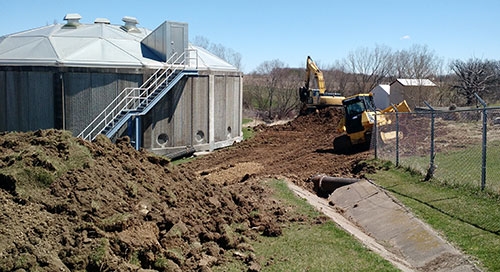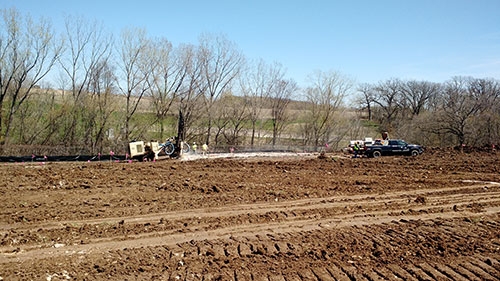You are here
Home ›Work begins on wastewater treatment plant upgrade in Waukon

Preliminary work begins on new wastewater treatment plant in Waukon ... Crews have begun preliminary site work on the wastewater treatment plant upgrade being constructed in Waukon. The new plant is a result of needing to meet mandated Environmental Protection Agency and Department of Natural Resources standards for wastewater treatment and will allow for greater flow capacity as well as a more environmentally friendly and efficient processing of the variety of waste material encountered by the City. The photo above shows work on the roadway that will lead to the newly constructed plant, while the photo below shows a blasting crew breaking up the limestone to prepare the area where the new plant will be constructed, which will be south of the current plant pictured above. Original plans are to have the new plant constructed and operational by September 2020. Photos courtesy of the City of Waukon Water and Sewer Department.

by Lissa Blake
After years of discussion, work began last week on the $12.3 million upgrade of Waukon’s wastewater treatment plant. The plant, which originally was built in 1965, has not seen any renovations since 1986.
A typical upgrade can usually keep a city in compliance with Department of Natural Resources (DNR) and Environmental Protection Agency (EPA) standards for about 20 years. It’s been almost 33 since anything has changed in Waukon.
“That’s far beyond its expected lifespan,” explained Waukon City Manager Dean Hilgerson.
In 2015, following a review by the Environmental Protection Agency, the City of Waukon was issued a compliance order from the EPA, indicating it needed to bring its water treatment capabilities up to Agency standards, “to restore and maintain the chemical, physical, and biological integrity of the Nation’s waters.”
In order to renew its National Pollutant Discharge Elimination System (NPDES) permit, the City had to either comply with new standards or at least have a plan in place to do so. As a result, City officials decided to go ahead with plans to make the needed improvements.
THE COST
Hilgerson explained the original engineer’s estimate for the project was $8.7 million, but when bids came in, they were much higher. The final bid for the project, submitted by Wapasha Construction of Winona, MN, came in at about $11.2 million, bringing the total estimated cost for engineering and construction together to about $12.3 million.
“Higher bids right now are not the exception. We had six general contractors bid the project and it was a pretty tight range,” said Hilgerson, citing tariffs and other factors which are driving up the cost of materials.
THE PROJECT
Waukon Water and Sewer Superintendent Jim Cooper explained the original plant, which utilized “trickling filters,” was not built to handle the type of waste the city has today. A trickling filter system consists of a fixed bed of rocks, coke (similar to coal), gravel, slag, polyurethane foam, sphagnum peat moss, ceramic or plastic media over which sewage or other wastewater flows downward and causes a layer of microbial slime to grow, covering the bed of media.
“As the city of Waukon’s treatment needs change, there is a need for a newer style treatment plant. The old plant was designed mainly for domestic waste and not industry or factory waste,” said Cooper.
In addition, Cooper explained the Iowa DNR has mandated its nutrient reduction strategy for all communities. “To help the hypoxic or ‘dead zone’ in the Gulf of Mexico, we had to have a strategy for phosphorous and nitrogen removal,” said Cooper.
NEW SYSTEM
Cooper explained the new plant will utilize an Ovivo Oxidation ditch, which will help lower the nitrogen and phosphorous before it is discharged. “After it goes through the ditch, it will go through two final clarifiers, followed by ultraviolet disinfection,” he said.
At the plant’s headworks building, there will be a new grit removal and bar screen removal system, which will help remove solids before the water goes into the plant.
“The main treatment difference is in the Ovivo ditches, we will have living organisms that will eat the organic waste. That will give us more control over what is coming into the plant,” he said.
Cooper said one of the biggest advantages of the new system will be the way it handles the city’s solids. The old system utilized an anaerobic digester, and the liquid had to be kept at 99 degrees year-round until it was sent out to be spread on farmers’ fields.
The new ultraviolet disinfection system will add a polymer to wet waste to turn it into dry waste that can be easily stored until farmers are ready to spread the organic matter on their fields.
“This is a huge upgrade. Many places have gotten rid of the old chlorine treatment option and opted for ultraviolet disinfection. This will help us to handle more load and more flow,” he said.
NEW JETTER
Cooper said while better flow should help move waste water out of the sewer system into the plant more efficiently, the City’s recent purchase of a new sewer jetter machine will help keep sewer lines clear as well.
“We’re implementing a new protocol to jet sewer lines in the city. Whenever we have free time this summer, we will be pulling the new jetter out. This will be a huge improvement. The new one will work a lot better and have a lot more power,” he said.
COST TO THE PUBLIC
Hilgerson explained the City really had no choice in the matter, as to whether or not to pursue this project. “This was a mandate from the EPA,” he said.
When asked how the City plans to fund the improvements, he said it will be done through the DNR’s State Revolving Fund, which will then be paid off by an increase in sewer usage fees. “The City is borrowing $10 million in funds at two percent interest,” he said, adding, if necessary, the City has a contingency plan to use TIF (tax increment financing) funds.
Hilgerson explained projects of this type are ineligible to be paid for through property tax increases, so they have to be paid for through rate increases. “The way the State looks at it is that the City is providing a commodity and the commodity price has to cover the cost of supplying it,” said Hilgerson.
He said historically, Waukon’s sewer and water rates have fallen well below those of other cities, as was evidenced during an application for a Community Development Block Grant (CDBG) to help fund the new plant.
“We were denied, because even though Waukon has a high LMI (low- and moderate-income) population, they said we weren’t charging enough,” said Hilgerson. In effect, the water/sewer rate wasn’t high enough to indicate the LMI population needed assistance.
He said plans are in place to raise water/sewer rates incrementally over the next few years. A 40 percent increase went into effect July 1, 2018, with another increase expected this July and additional subsequent increases to follow. “Every small town is faced with the same situation right now. It’s a compliance issue. We have to meet State DNR and EPA standards,” Hilgerson said.
INFRASTRUCTURE CONCERNS
When asked if the new wastewater treatment plant upgrades will help eliminate back-up of sewage into people’s homes, Hilgerson said the efficiencies of the new plant should help with flow, but that specific infrastructure will have to be addressed separately. “Our goal is that with our new rates, part of that will include funds for continued maintenance and improvement of our infrastructure,” he said.
PUBLIC EDUCATION
Cooper said although the City of Waukon didn’t really have a choice in the matter, he sees the upgrades as a “big improvement” which will help Waukon for years to come. “We need to make sure we can meet the legal guidelines and limits, and I have no doubt we will because of what the City is investing in,” he said.
Cooper added once the new plant is completed, he plans to host an open house so people can come see how everything works together. “We always welcome tours and anyone who is interested in learning about what happens to their water once it leaves their home,” he said.
Cooper explained there should be no interruptions in anyone’s service during the project, which is slated for completion September 2020.

